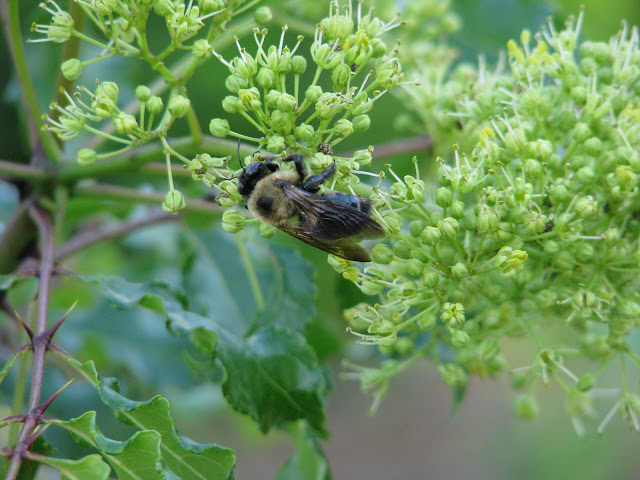In the spring, the trees are covered with clusters of greenish yellow flowers. The tallest of my trees reaches almost 6 feet and had more flowers this year than in previous years. I was surprised to find that the flowers have a rather strong scent that reminds me of honeysuckle. Here are a few photos of the many insects that were swarming around the flowers recently.

Common Buckeye Butterfly

Several Red Admiral Butterflies fed on the flowers of the trees

A Hairstreak Butterfly rested on a shiny and thorny leaf

A native bee that I will not attempt to identify

Another native bee that will go unidentified and a ladybug beetle

Honeybee and a fly

And a wasp fed on the nectar of the flowers.
But that's not all...

The trees are host plants for the caterpillars of the Giant Swallowtail Butterfly. The caterpillars are not always easy to see because they are camouflaged to look like bird droppings, as seen in this photo from a couple of years ago. I have not seen any caterpillars yet this year, but I did see a Giant Swallowtail flying around the garden a few days ago.
And there's more...
The flowers produce small fruits that are a favored by birds. I have not had any fruits on my trees yet. Maybe this year will be the first since there were so many flowers.
But that's still not all...
Humans can benefit from trees of the genus Zanthoxylum. If you get a toothache, you can chew on the leaves or bark of the trees and your mouth will become numb. Just watch out for the thorns.
But that's still not all...
Humans can benefit from trees of the genus Zanthoxylum. If you get a toothache, you can chew on the leaves or bark of the trees and your mouth will become numb. Just watch out for the thorns.
Look for these trees at native plant sales this spring. The North Central Texas Chapter of the Native Plant Society of Texas has had Toothache Trees at their plant sales for the last couple of years. This was the source of my trees. Their spring plant sale is April 21 at the Fort Worth Botanic Garden. Toothache Tree is not on their list of available plants this year, but maybe they will have some anyway.

Wow...that is like the Swiss Army Knife of trees...so much bang for the buck!
ReplyDeleteScott, it is a multipurpose tree and the thorns could poke you like a knife if you are not careful.
DeleteA very nice and useful tree in the garden. I have heard of it but don't remember seeing in available anywhere.
ReplyDeleteOn a personal note: We will be in Plano to visit family at the end of May and would love to see the prairie garden, even it's only a "drive by". I couldn't find an email for you so my email is stffox1@gmail.com.
Shirley, the trees are common in wooded areas around here, often as an understory tree. I have seen them in a couple of local native plant sales and I have a feeling they all came from the same person's yard.
DeleteI will send an email to you. You are welcome to drive by or stop for the 5 cent tour.
I loved how you kept saying - and there's more! Like a commercial. Well, you've sold me. I've never seen one of these, but if I ever run across one, I'll be sure to pick it up!
ReplyDeleteMy sales pitch worked HolleyGarden and I did not even list all of the uses for the tree. Apparently it is used as a herbal remedy for several ailments such as rheumatism, dyspepsia, dysentery, heart and kidney troubles.
DeleteI learn something new every time I visit your blog. Great photo of the swallowtail chrysalis.
ReplyDeleteThanks Collagemama. Have you seen the Hercules Club trees at the Arbor Hills Nature Preserve? They are all along the trails. By the way, that is a swallowtail caterpillar. It disappeared a few days after I took the picture. I looked around and never saw a chrysalis.
DeleteI love your insect photography! Very Nice! I just love a plant that can fill a niche so well in an ecosystem. Truly Wonderful!
ReplyDeleteThanks Lucy. I am still a curious kid when it comes to nature. I used to keep my insects in jars. Now, I create habitats for the insects and photograph them.
DeleteMarilyn, I don't know where your comment went. Blogger does crazy things sometimes. I had to look up Anahuac Refuge. I was not aware of this place.
ReplyDeleteHello Michael, I very much enjoy your blog. As you might know, Zanthoxylum species are male or female. All of the flowers in your pictures are male (they have stamens, which are lacking in the flowers of female trees). If all the pictures are from one tree then perhaps one of your other trees is female. However, if these pictures are from all three trees, then they are all male and they will not bear fruit.
ReplyDeleteThanks for the info, Rufino. I did not know that there are male and female trees. I never paid much attention to the flowers because I assumed they were monoecious. That explains why I did not get any fruit. Those photos are from my two larger trees. I have one more that is still small. It tried to bloom this year, but I pinched the flowers off so it could use all of its energy toward growth. Thanks for the comment.
ReplyDelete